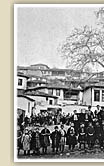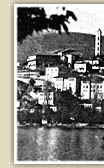|
|
 |
 |
 |
 |
 |
 |
 |
 |
 |
 |
|
Populations of different cultural origins and different languages
lived in Macedonia. Until the nineteenth century it remained a deeply traditional society
with no pattern as concerned the national identity of its populations,
|

especially in rural areas. After the
Tanzimat reforms, all Orthodox Christian populations in the Ottoman Empire belonged to the millet-i Rum
under the leadership of the Patriarch of Constantinople, independently of
linguistic or other cultural differentiations. In this area,
after the mid-nineteenth century, the national ideologies of the newly-established Balkan
states began to spread.
This development was accompanied by an increasing number of maps and statistical surveys
of the area, by means of which it was believed that the supremacy of one
or other nationality could be proven. Usually these map-makers were obeying orders,
under the command of one Balkan state or another, which covered all expenses.
The basic problem of these surveys was that they did not take into account the fact that
national consciousness is determined by the people's free will and not by biological
characteristics or language. Many Slav-speaking Macedonians, for instance,
chose to preserve their traditional relationship with the Patriarchate and not
give in to the Bulgarian Exarchate; and they eventually identified with the Greek side.
The statistical data appearing on maps were of relative value only, as the appearance of armed bands, the vested interests of inhabitants,
national and religious tensions changed several times before, during and after the Macedonian
Struggle. There were also indications that the data used was inaccurate,
while the citeria set served the interests of each country. Thus,
the Bulgarians put forward language, whereas the Greeks religious alignment (Patriarchists/Exarchists).
These categories are not similar, cannot be compared to each other and no one can securely determine
the existence of national consciousness among the populations of Macedonia.
|
 |

At the same time, there were other factors rendering the issue of population
distribution in space even more complex. For instance, close relatives made different national choices or
the same individual changed national-religious camps in the span of his life.
In order to get a more representative picture of national feeling at the
beginning of the twentieth century, it is useful to go back to the distribution
of schools in Macedonia. According to the Istituto
Geografiko de Agostini of Rome, in 1903 there were in the vilayets of Thessaloniki
and Monastir 998 Greek schools with 59,640 students, 561 Bulgarian schools
with 18,311 students, 49 Romanian schools and 53 Serbian schools with 2,002 and 1,674
students respectively. Examining this Greek supremacy we must take into account
that Greeks predominated in the cities, especially in areas of commercial and
industrial activity, and were already involved in education.
The knowledge of the Greek language from the eighteenth century all over the Balkan peninsula
was a sign of increasing social mobility, and also of high-prestige professions and social positions, rather than just with origin.
By contrast, the Bulgarian-Exarchist predominated in rural populations
with little education. What is certain is that the correlation of
schools demonstrates the cultural supremacy of the Greeks at this time.
In northern Macedonia the Bulgarian schools were in the majority whereas in southern Macedonia Greek schools predominated. Competition was intense in central Macedonia, which has also been
the battlefield witnessing most of the crucial clashes of the Macedonian Struggle.
|
 |
 |
|
